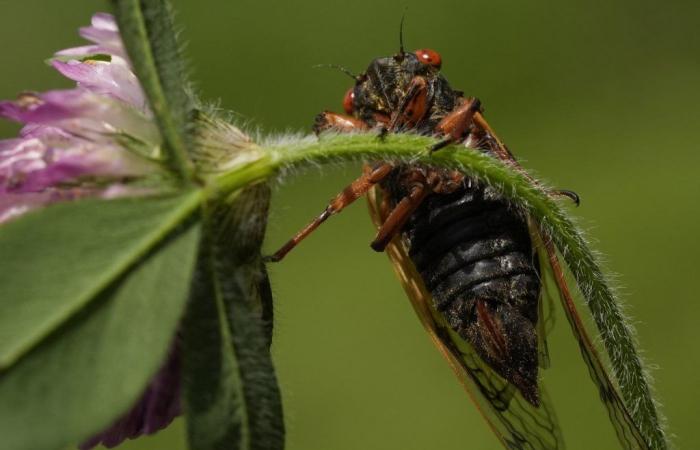The ground seemed to undulate at night, alive with critters. Creeping cicada nymphs, seeking to rise after 17 years underground, flocked to trees and climbed them, stopping to shed their skin and emerge as adults. That’s when the fun began.
The chaos of cicadas flourishes and flies away. Trillions of once-hidden baby bugs are in the air, on trees, and perched on people’s shirts, hats, and even faces. They have red eyes, are noisy and wriggling. “What you saw was biblical,” said biologist Gene Kritsky, who has hunted periodical cicadas for 50 years but was stunned by the 3 to 5 million cicadas crowding a small patch of the conservation area. from Ryerson, north of Chicago. There are things I saw this time that I’ve never seen before.” This is a unique spectacle in the United States, the last in the Triple Crown of rare natural wonders planned in advance.
First there was the solar eclipse in April, then the Northern Lights in May, unusually far to the south. Today, the great periodic cicada emergence of 2024 ― an event of a scale not seen since 1803 ― has burst into the skies to join previous spectacles. It lasts weeks longer than the other two ephemeral natural rarities, but in many places the cicada invasion is beginning to peter out. Males sing for sex and will not stop until they gain consent from a wing-flapping female cicada. In some places in Illinois, the decibel level reached 101, louder than a lawn mower, flowing in waves as a pervasive buzz that sounds like the descent of aliens in a movie. science fiction.
The sound abounds in Chicago suburbs, such as Oak Brook, but has already faded further south in the state, including where two broods overlap. At an asphalt-covered DuPage County shopping center, cicadas crowding the branches of the single tree drowned out the whir of pipes and brushes from the nearby car wash. Cicada hunters from 18 states across the Midwest and South sent photos of the insects to the Cicada Safari app, primarily concentrated in two areas, each an emergence of different broods. The Northern Illinois brood, called XIII and appearing every 17 years, is very dense, with up to 1.5 million insects per tree-covered acre ― or nearly a billion per square mile ― in some places like Ryerson, Mr. Kritsky said. The Great Southern Brood, which arrives every 13 years, ranges from Virginia to Missouri and from southern Illinois to Georgia.
In central Illinois, particularly around Springfield, the two broods barely overlap. But it is difficult to know which brood a cicada belongs to. Rebecca Schmidt, an entomologist with the U.S. Department of Agriculture, said that usually when she gets calls about insects, it’s something bad and scary, like murder hornets. Periodical cicadas are different and “people come to us for good reasons, like ‘tell us more, we’re very excited, enthusiastic about this,'” she said. “It’s a nice little gateway to these amazing things that the natural world does, some of which can be predicted very accurately,” Ms. Schmidt added.
Lily Tolley, a 6-year-old from Springfield, can’t get enough of cicadas. She even feeds them to her lizard, Dart. When a cicada approached her front door, it lunged at her doorbell camera and showcased it, up close and far. She can tell the difference between mute females and noisy males, describe the different parts of the cicada, and describe the “kinda stinging” feeling we get when a cicada walks over us. Don’t worry, she quickly adds, it doesn’t hurt. Yet many people are frightened or disgusted by the trillions of flying insects that die shortly after mating in a pile on the ground. “Scary crawling animals are probably the most common fear people have,” says Martin Antony, the chair of the department of psychology at Metropolitan Toronto University and the director of the Anxiety Research and Treatment Laboratory there. university.
A long time ago, people had to be alert to danger, which is explained by evolution. “There is nothing dangerous about cicadas, but they can share potentially threatening or disease-carrying characteristics with other animals,” Antony said. The only possible danger is to young trees, mainly when females cut into the branches to lay their eggs, Rydzewski said. This is why many newly planted trees sport a white protective netting, which contrasts with the black winged insects lining some mature trees. Generally speaking, cicadas play an important role in the local ecosystem as fertilizer, aerating the soil and serving as food for birds and other animals, says Marvin Lo, a plant root biologist. trees at the Morton Arboretum. He collected cicada carcasses from one area, ground them in his lab into a stinking powder that he would measure and test later.
The arboretum was filled with cicadas, cicada watchers, and scientists observing the insects. The critters did not disappoint. They were present in strength and weirdness. The Associated Press has found a blue-eyed cicada, a one-of-a-kind discovery. Mr. Kritsky also found his first blue-eyed cicada in the Ryerson woods. It’s a question of numbers. Even if there are only one in a million, a small plot of land will have a few, because there are a lot of cicadas. The biologist, who wrote a book on this double emergence, affirms that the invasion of cicadas is fading, but that he is still looking for more. “In about two weeks, the invasion will be substantially over,” Mr. Kritsky said. It was a real explosion.”
Caption and photo credit: AP Photo/Carolyn Kaster.






